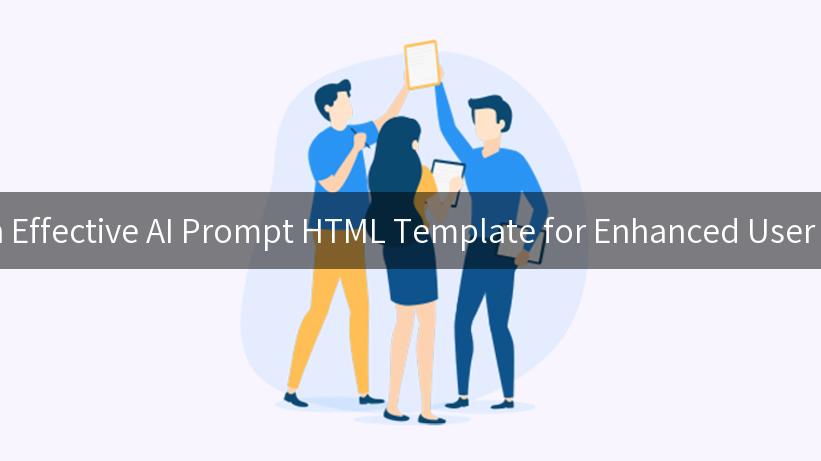
In today’s digital age, the integration of Artificial Intelligence (AI) into applications and services has not only revolutionized user experience but also improved operational efficiency dramatically. As developers, it is crucial to harness the potential of AI in a way that resonates with users, and one of the best ways to achieve this is by creating an effective AI prompt HTML template. This article will guide you through the steps to create such a template, improve API calls using tools like tyk, and understand essential concepts like Additional Header Parameters.
What is an AI Prompt HTML Template?
An AI prompt HTML template serves as a bridge between the user and AI services. It provides the means for users to interact with the AI system effectively, sending prompts that guide the AI’s responses. An effective template enhances user satisfaction, reduces confusion, and offers a seamless experience, allowing users to focus on their queries rather than how to input them.
The Importance of An Effective Template
- Enhanced User Engagement: A well-designed prompt template captures user attention, making interactions with AI more intuitive.
- Increased Efficiency: Streamlining the user input process minimizes backend processing time.
- Lower Error Rates: Clear guidance reduces the chances of users making input errors, leading to more accurate AI responses.
- Data Validation: Implementing validation methods within the HTML template ensures the data sent to the backend complies with the expected format.
How to Create an AI Prompt HTML Template
Creating an effective HTML template for AI prompts encompasses several essential steps:
Step 1: Set Up Your HTML Structure
Begin with a basic HTML structure where users can input their queries. Here’s a simple example:
<!DOCTYPE html>
<html lang="en">
<head>
<meta charset="UTF-8">
<meta name="viewport" content="width=device-width, initial-scale=1.0">
<title>AI Prompt Interface</title>
<link rel="stylesheet" href="styles.css">
</head>
<body>
<div id="prompt-container">
<h1>Welcome to AI Assistant</h1>
<textarea id="user-input" placeholder="Type your question here..."></textarea>
<button id="submit-prompt">Submit</button>
<p id="response"></p>
</div>
<script src="script.js"></script>
</body>
</html>
Step 2: Styling Your Template
Using CSS, we can enhance the visual appeal of the prompt template. For instance:
#prompt-container {
width: 50%;
margin: 0 auto;
text-align: center;
}
#user-input {
width: 100%;
height: 100px;
margin: 10px 0;
}
button {
background-color: #4CAF50;
color: white;
padding: 10px 20px;
border: none;
cursor: pointer;
}
Step 3: Setting Up API Calls
To connect your HTML template with an AI service via API, you will need to utilize JavaScript. Below is a simple JavaScript snippet that sends an API request and displays the response:
document.getElementById("submit-prompt").addEventListener("click", function() {
let userInput = document.getElementById("user-input").value;
let apiUrl = "http://api.example.com/ai"; // Replace with your API endpoint
fetch(apiUrl, {
method: 'POST',
headers: {
'Content-Type': 'application/json',
'Authorization': 'Bearer your_api_token' // Replace with your auth token
},
body: JSON.stringify({ input: userInput }),
})
.then(response => response.json())
.then(data => {
document.getElementById("response").innerText = data.reply;
})
.catch(error => console.error('Error:', error));
});
Step 4: Using Additional Header Parameters
When dealing with diverse AI services, you might need to incorporate Additional Header Parameters in your API requests. This customization can include specifying content types, user-agent strings, or any additional tokens required by the service provider.
An example of adding additional headers in a fetch request is:
fetch(apiUrl, {
method: 'POST',
headers: {
'Content-Type': 'application/json',
'Authorization': 'Bearer your_api_token',
'X-Custom-Header': 'value' // Example of an additional header parameter
},
body: JSON.stringify({ input: userInput }),
});
Step 5: Integrate API Gateway with Tyk
Utilizing API management tools like tyk can simplify the process of managing your API calls. Tyk provides a centralized management dashboard, where you can monitor API usage, handle traffic, and enforce security policies. Here’s a simple table summarizing the benefits of using Tyk:
| Feature |
Description |
| Traffic Management |
Efficiently handles incoming API requests and distributes load appropriately. |
| Analytics |
Provides data insights and statistics on API usage. |
| Security |
Offers built-in security features such as rate limiting and authentication. |
| Version Control |
Supports multiple versions of APIs, ensuring compatibility and smooth transitions. |
| Documentation |
Automatically generates and hosts API documentation for developers. |
Step 6: Testing Your Template
Before deploying your AI prompt template, it’s imperative to perform thorough testing. Conduct usability tests to gather feedback from real users. Adjust your design based on this feedback to ensure maximum efficiency and satisfaction.
Conclusion
Creating an effective AI prompt HTML template plays a crucial role in enhancing user experience with AI services. By focusing on user engagement, backend efficiency, and using tools like tyk, developers can create a robust and intuitive interface for users to interact with powerful AI capabilities.
Implementing Additional Header Parameters and adhering to best practices in API calls will also significantly contribute to your project’s success. Start building and refining your templates today to leverage the full potential of AI in your applications.
APIPark is a high-performance AI gateway that allows you to securely access the most comprehensive LLM APIs globally on the APIPark platform, including OpenAI, Anthropic, Mistral, Llama2, Google Gemini, and more.Try APIPark now! 👇👇👇
In summary, investing time and resources in creating an effective AI prompt HTML template is a strategic move toward improving user satisfaction and operational performance. Feel free to explore and experiment with this guide to unlock the capabilities of AI and elevate user experience.
Integrating the discussed features can lead to a more engaging and streamlined interaction, which is ultimately what every application should strive for in the age of AI.